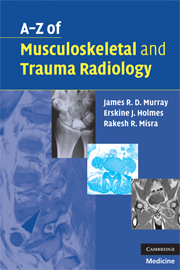Book contents
- Frontmatter
- Contents
- Acknowledgements
- Preface
- List of abbreviations
- Section I Musculoskeletal radiology
- Achilles tendonopathy/rupture
- Aneurysmal bone cysts
- Ankylosing spondylitis
- Avascular necrosis – osteonecrosis
- Femoral-head osteonecrosis
- Kienböck's disease
- Back pain – including spondylolisthesis/spondylolysis
- Bone cysts
- Bone infarcts (medullary)
- Charcot joint (neuropathic joint)
- Complex regional-pain syndrome
- Crystal deposition disorders
- Developmental dysplasia of the hip (DDH)
- Discitis and vertebral osteomyelitis
- Disc prolapse – PID – ‘slipped discs’ and sciatica
- Diffuse idiopathic skeletal hyperostosis (DISH)
- Dysplasia – developmental disorders
- Enthesopathy
- Gout
- Haemophilia
- Hyperparathyroidism
- Hypertrophic pulmonary osteoarthropathy
- Irritable hip/transient synovitis
- Juvenile idiopathic arthritis
- Langerhans-cell histiocytosis
- Lymphoma of bone
- Metastases to bone
- Multiple myeloma
- Myositis ossificans
- Non-accidental injury
- Osteoarthrosis – osteoarthritis
- Osteochondroses
- Osteomyelitis (acute)
- Osteoporosis
- Paget's disease
- Perthes disease
- Pigmented villonodular synovitis (PVNS)
- Psoriatic arthropathy
- Renal osteodystrophy (including osteomalacia)
- Rheumatoid arthritis
- Rickets
- Rotator-cuff disease
- Scoliosis
- Scheuermann's disease
- Septic arthritis – native and prosthetic joints
- Sickle-cell anaemia
- Slipped upper femoral epiphysis (SUFE)
- Tendinopathy – tendonitis
- Tuberculosis
- Tumours of bone (benign and malignant)
- Section II Trauma radiology
Ankylosing spondylitis
from Section I - Musculoskeletal radiology
Published online by Cambridge University Press: 22 August 2009
- Frontmatter
- Contents
- Acknowledgements
- Preface
- List of abbreviations
- Section I Musculoskeletal radiology
- Achilles tendonopathy/rupture
- Aneurysmal bone cysts
- Ankylosing spondylitis
- Avascular necrosis – osteonecrosis
- Femoral-head osteonecrosis
- Kienböck's disease
- Back pain – including spondylolisthesis/spondylolysis
- Bone cysts
- Bone infarcts (medullary)
- Charcot joint (neuropathic joint)
- Complex regional-pain syndrome
- Crystal deposition disorders
- Developmental dysplasia of the hip (DDH)
- Discitis and vertebral osteomyelitis
- Disc prolapse – PID – ‘slipped discs’ and sciatica
- Diffuse idiopathic skeletal hyperostosis (DISH)
- Dysplasia – developmental disorders
- Enthesopathy
- Gout
- Haemophilia
- Hyperparathyroidism
- Hypertrophic pulmonary osteoarthropathy
- Irritable hip/transient synovitis
- Juvenile idiopathic arthritis
- Langerhans-cell histiocytosis
- Lymphoma of bone
- Metastases to bone
- Multiple myeloma
- Myositis ossificans
- Non-accidental injury
- Osteoarthrosis – osteoarthritis
- Osteochondroses
- Osteomyelitis (acute)
- Osteoporosis
- Paget's disease
- Perthes disease
- Pigmented villonodular synovitis (PVNS)
- Psoriatic arthropathy
- Renal osteodystrophy (including osteomalacia)
- Rheumatoid arthritis
- Rickets
- Rotator-cuff disease
- Scoliosis
- Scheuermann's disease
- Septic arthritis – native and prosthetic joints
- Sickle-cell anaemia
- Slipped upper femoral epiphysis (SUFE)
- Tendinopathy – tendonitis
- Tuberculosis
- Tumours of bone (benign and malignant)
- Section II Trauma radiology
Summary
Characteristics
Spondyloarthropathy affecting 5/1000 of the Caucasian population – only 10% develop significant symptoms.
Predominantly a genetic aetiology (> 90%) with HLA B27 conferring a relative risk increase of 120, although this is not the only genetic inheritance factor in ankylosing spondylitis.
Young adults, M : F = 3 : 1.
Clinical features
Thoracolumbar and lower back pain with stiffness. Buttock pain with radiation down the posterior thigh but not below the knee.
Morning stiffness and night pain are common.
Costochondral/costovertebral pain, sometimes causing respiratory disease.
Coexistent plantar fasciitis, iritis (30%), Achilles tendonopathy, inflammatory bowel disease (10%), psoriasis (10%) and major-joint involvement (20%). Cardiac problems occur in 1%.
Progressive lumbar flattening and thoracic kyphosis, in conjunction with soft-tissue flexion contractures of the hip produce the characteristic ‘question mark’ posture.
Further exacerbation of the thoracic kyphosis may be due to osteoporotic wedge fractures, which are not uncommon.
Radiological features
Sacroiliitis is a pre-requisite for diagnosis. Look for early marginal sclerosis on the iliac side of the sacroiliac joint (SIJ), usually starting in the inferior 1/3 (synovial part) of the SIJ. Complete SIJ ankylosis is a late sign.
Osteitis results in squaring of vertebral bodies. The earliest signs of spondylitis are manifest as small erosions at the corners of the vertebral bodies – the so-called Romanus lesion. Syndesmophyte formation eventually lead to classical ‘bamboo spine’.
Osteoporosis and kyphosis occur with long-standing disease.
Extra-axial skeletal involvement mimics mild rheumatoid arthritis.
Management
NSAIDs and physiotherapy form the bulk of treatment.
- Type
- Chapter
- Information
- A-Z of Musculoskeletal and Trauma Radiology , pp. 10 - 12Publisher: Cambridge University PressPrint publication year: 2008



